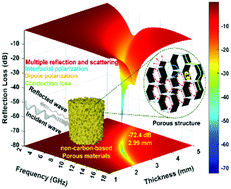High performance microwave absorption of light weight and porous non-carbon-based polymeric monoliths via a gel emulsion template†
Abstract
Special porous non-carbon-based microwave-absorbing materials are designed and synthesized by bonding di(prop-1-en-2-yl) ferrocene into porous polymeric monoliths made by using gel emulsions as templates. In this study, a series of porous non-carbon-based materials (M1–M6) that have light weight, high-performance microwave absorption, adjustable, environmentally friendly, and low energy consumption properties were prepared. The microwave absorption performance of these materials could be effectively enhanced by easily adjusting the dispersed phase of the gel emulsions to control the porosity of the materials, which is a simple and effective way to obtain high-performance microwave absorption materials. With the increase of the porosity, the materials could boost the dielectric loss ability and impedance matching behavior. When the porosity of the monolith M6 reaches 94.6%, the minimum reflection loss is −72.4 dB at 2.99 mm and the corresponding effective bandwidth can reach 6.24 GHz ranging from 10.24 to 16.48 GHz, which exhibits a superior specific reflection loss. In addition, the minimum reflection loss of the other porous polymeric monoliths (M1–M5) could also reach high values of −26.4 dB, −59.9 dB, −64.1 dB, −60.3 dB and −56.2 dB, respectively. The light weight porous polymeric monoliths (M1–M6) obtained by this novel strategy show one of the best performances among microwave absorbers.



 Please wait while we load your content...
Please wait while we load your content...